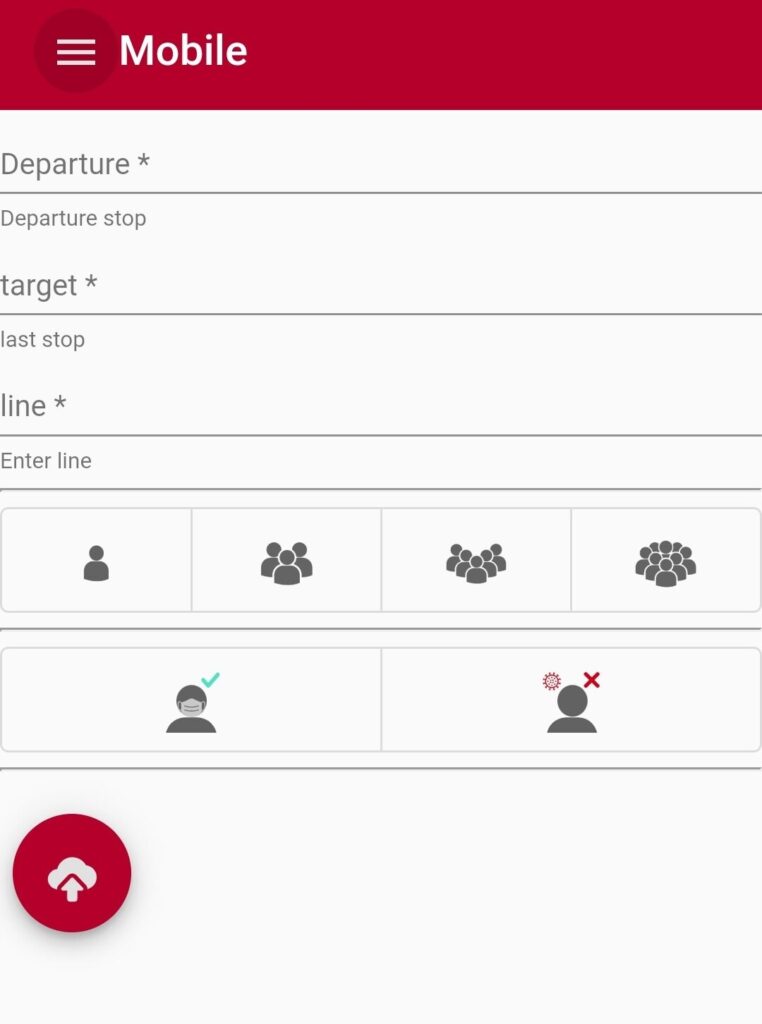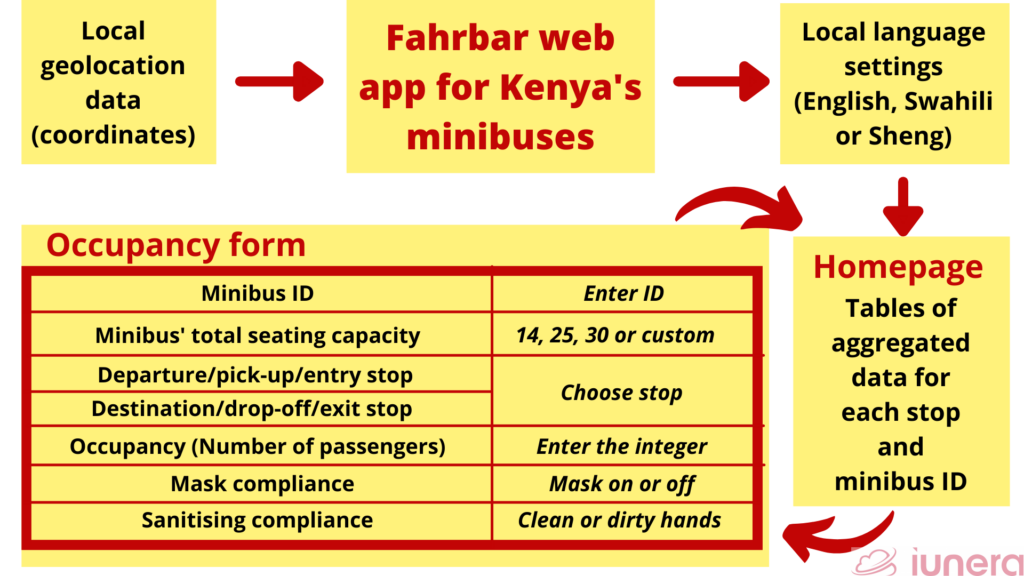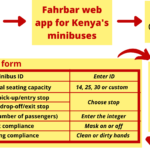This post is also available in: Deutsch (German)
Since each country’s transport system differs from another, we need to think about whether we can apply our web app Fahrbar in a different transport setting and how. Here’s a hypothetical example: Applying Fahrbar in Kenya’s minibus system.

Image Source: My writer Samuel gave this to me.
A reminder of public transport’s role
If everyone had a gasoline-powered car, the planet would be so polluted! As imagined by the BBC Science Focus Magazine, the cost of giving a global population of 7.5 billion people their own cars would be an additional 5.6 billion tonnes of steel, 36 million kilometres of road, at least 32.5 billion litres of petrol and an additional 13 billion tonnes of annual CO2 emissions!
The seriousness of this problem demonstrates why public transport’s long-term significance can be seen in its role in climate action and transporting people who don’t drive, especially in developing countries like Kenya. At the same time, without a clear end in sight for the Covid-19 pandemic, we want people to lay their fear of infection to rest and safely use public transport. So, let’s tap into our imagination and determine whether Fahrbar, our web app for public transport occupancy, can be used in a different transport setting like Kenya’s.
Hypothetical Example: Kenya’s minibus, the matatu
As spoken in our article about Kenya’s transport system, Kenya’s transport is dominated by paratransit, particularly the matatu system, which is a minibus system characterised by flexibility and demand-responsiveness. Each minibus has 2 workers on duty: a driver and a tout. The tout is basically a conductor in charge of fare payments, passengers, and the vehicle’s condition.
There are 2 types of conductors: organised and unorganised. The organised conductors are usually said to be older and more respectful while the unorganised conductors are usually younger and less respectful. Note that conductors usually sit with the passengers, not in the front seats with the drivers.
It was also pointed out that there are several challenges in the minibus system, one of which is that conductors would have more to lose from the Transport Ministry’s plan to digitalise the fare payment system given that they’re the fare collectors.
Additionally, there is now a requirement for paratransit operators, including minibuses, to join savings and credit coops (SACCOs). For example, I’ve been told that one of the SACCOs plying the Ongata Rongai route is the Orokise SACCO. Many more orderly SACCOs ply other routes, but there are also disorderly SACCOs in the same vein.

Image Source: My writer Samuel gave this to me.
Fitting Fahrbar into Kenya’s minibus system
The data projects for the minibuses have proven that the minibuses can be data-driven with the usual public transport concepts of convenience, occupancy, punctuality, recurring delays, demand, entries, exits, transfers, and route optimisation despite the differences in size, scale, and challenges.
Let’s see how Fahrbar can be applied here.
What remains the same?
- Purpose of monitoring occupancy, particularly to social distance during the Covid-19 pandemic.
- The non-text user interface.
- The conductors can still key in the departure stop, destination, occupancy levels and mask compliance fields.
What changes in this context?
- The official languages of Kenya are English and Swahili while Sheng is a local creole. The conductors in charge should be able to use the web app in either English, Swahili or Sheng, whichever they’re comfortable with.
- The biggest change to the Fahrbar web app for Kenya would be the geolocation data such as coordinates and routes.
- The schedules and routes are not fixed due to the flexible and demand-responsive nature of the minibuses, so conductors cannot key in the transport line field and may even have to key in more than one departure stop and destination because of the flexibility in stops per passenger. This can get troublesome for conductors with less patience. Instead, a minibus ID should be entered.
- Details about the minibus’ total number of seats need to be keyed in as a dedicated field for minibus size in the occupancy form. For example, is the minibus in operation a 14-seater, 25-seater or 30-seater?
- Symbols for occupancy might need to be changed to the number of available seats occupied between stops to make it easier for the conductor to enter the data based on the tally.
- The minibus passengers are now required to wash/sanitise their hands before boarding. This means that the conductors need a field in the occupancy form to report handwashing/sanitising compliance.

Other questions to consider
Seating
Some questions about occupancy and maximum seating capacity might remain similarly applicable in this use case. Example: What is the maximum passenger seating capacity in each minibus (excluding the conductor who sits in the passenger section)? According to The Star Kenya‘s July 2020 article, the answer to this question is the maxima of 8 for 14-seater minibuses, 15 for 25-seater minibuses, and 60% for 30-seater minibuses.
Resource allocation
Maybe Fahrbar can answer questions about resource allocation. To meet the maximum seating capacity in each minibus and the demand for minibus rides, how many minibuses, conductors and drivers are needed?
Let’s try the math ourselves.
#Define the variables for the staff, minibus and passengers:
t = Number of conductors (touts), d = Number of drivers, m = Number of minibuses, p = Number of passengers
#1 minibus requires 1 driver and 1 conductor: t = d = mHowever, this is assuming that all minibuses are of the same size. How about minibuses of different sizes?
#Consider minibuses of different sizes:
m14 = Number of 14-seater minibuses, m25 = Number of 25-seater minibuses, m30 = Number of 30-seater minibuses, m = Total number of minibuses = m14 + m25 + m30 = t = d
#Remember the maxima of 8 for 14-seater minibuses, 15 for 25-seater minibuses, and 60% (0.6*30=18) for 30-seater minibuses:
p14 = Number of passengers per 14-seater minibus, maxp14 = Maximum seating capacity per 14-seater minibus =< 8
p25 = Number of passengers per 25-seater minibus, maxp25 = Maximum seating capacity per 25-seater minibus =< 15
p30 = Number of passengers per 30-seater minibus, maxp30 = Maximum seating capacity per 30-seater minibus =< 18Let’s assume that the minibus demand reaches the threshold whereby the maximum seating capacity per minibus is always the case for each one of 10 rides within a day.
#Seating occupancy per minibus is always maximum:
p14 = maxp14 = 8, p25 = maxp25 = 15, p30 = maxp30 = 18, r = number of rides daily = 10 rides a day
#The number of __-seater minibuses needed to cater to __ passengers for every one of 10 rides in a day:
m14 = p14*r = 8*10 = 80, m25 = p25*r = 15*10 = 150, m30 = p30*r = 18*10 = 180
#Print the total number of minibuses and staff needed to meet the maximum within a day:
m = t = d = m14 + m25 + m30 = 80 + 150 + 180 = 410 Hence, 410 conductors and 410 drivers will need to be hired to operate 410 minibuses to run 10 rides within a day.
Alternatively, ITDP Africa has a formula for calculating the required frequency of minibuses or even normal buses per hour:
Required frequency=(Passenger volume)/(Bus capacity)
Example: (26,000 passengers/hr)/(120 passengers/bus)=217 buses/hrCurrent seating arrangement
Al Jazeera reported in March 2020 about the minibus’ standard operating procedures (SOP) during the pandemic. Like I mentioned earlier, the minibuses must provide hand sanitisers (or soap and water) for passengers to use before boarding and follow the maximum occupancy for social distancing. Other measures include cleaning the minibus twice a day and implementing contact tracing. Despite the SOP, the photos shown in the report weren’t so promising as the minibuses still looked crowded.
On the bright side, July 2020 reports by Kenyan news platforms Citizen Digital, Nairobi News and The Standard mentioned that minibus operators have redesigned their vehicle seating arrangements to enable social distancing compliance. Instead of the usual seat pairs, minibuses can now be seen with, say, a column of single seats on one side and a row of three seats together on the other side. Surprisingly, this change benefited the operators as the new seating arrangement gave them space for more passengers, and thus, more money.
People counting methods
For discussion’s sake, are there other people counting methods? Or will the conductor prefer manually counting the passengers and submitting the numbers through Fahrbar?
Since occupancy data is one of the data sets required for transport demand analysis, we might as well refer to it. As an example, ITDP Africa’s April 2021 Public Transport Demand Assessment has a frequency-occupancy (FO) survey which, as the term implies, looks at vehicle frequency and vehicle occupancy (including normal-sized buses) at morning and evening peak periods. ITDP’s survey team counted the passengers according to the occupancy level for efficiency:
“1. If most seats are empty: Count the number of seated passengers.
2. If most seats are full: Count the empty seats and subtract from the total number of seats.
3. If all seats are full: Count the number of standing passengers and add to the total number of seats.”
Counting the number of passengers in each vehicle efficiently according to ITDP Africa’s April 2021 Public Transport Demand Assessment
Besides this, a January 2020 CNN report featured how a Nairobi-based tech firm Data Integrated has been giving minibuses “a high-tech makeover” with real-time GPS tracking, mobile ticket sale machines and enhanced cameras that can count passengers, the figures of which can be cross-checked with ticket sales, to enable minibus owners to monitor operations and increase professional transparency. Ticket sales records and cameras are examples of people counting methods.
Another suggestion for an occupancy data source is GTFS. A 2015 paper about the digital matatu [minibus] project: using cell phones to create open-source data for Nairobi’s semi-formal bus system by Sarah Williams, Adam White, Peter Waiganjo, Daniel Orwa and Jacqueline Klopp pointed out that the GPS-based Mytracks app eases the gathering of transport metadata including, guess what, the number of passengers.
Potential advantages
- Easier reference for passengers when planning their journeys.
- Safety of passengers, drivers and conductors.
- Having the conductors play their role might make it easier for manual data collection since it helps the drivers focus on driving. With that said, Fahrbar should be taking advantage of their role instead of seeking to replace them.
- The fare system will be untouched (what a pun) by Fahrbar as the web app is not related to fare collections (but the conductors will still need to safely collect money).
- Younger conductors are more likely to be well-versed with touchscreen devices, making it easier for them to navigate the web app interface.
- Many minibuses are pimped, so identification of minibuses with custom designs might be easier (as long as they can be traced to their license plates or IDs and operators).
Potential disadvantages
- Distrust with tech. Will the minibus operators be receptive to Fahrbar? Can the minibus operators be convinced to use the web app?
- Institutional issues or requirements, taking into account that minibuses are privately-owned and have to join the SACCOs.
- The unorganised minibuses might be so used to the chaotic nature of doing business that they might forgo the data entry.
- Many conductors are often seen as rude and tough because they have to deal with passengers who don’t abide by their instructions. Conductors could be faced with challenges to ensure that passengers follow SOP and decide whether these passengers should be allowed on board.
- Older conductors might not be well-versed with touchscreen devices to navigate the web app interface.
How would the Kenyan Fahrbar’s conductor function look like?

The link to the Fahrbar web app for Kenya would have Kenya’s coordinates. A Kenyan minibus conductor’s guide to using Fahrbar would look like this:
How to use Kenyan Fahrbar's conductor function?*

*Hypothetically
- This web app requires switching on your device’s location to use it. The homepage of the web app features the departures at each stop. You can switch the language to English, Swahili or Sheng.
2. To report occupancy, there are two options:
- The bottom right of the homepage has a button saying “+ REPORT OCCUPANCY” that you can press.
- The top left of the site has a three-line drop-down menu that you can press to open a menu and select “Occupancy”.
3. Once you press either one of those buttons, you’ll see an occupancy reporting form as shown below. The occupancy reporting form consists of:
- Minibus ID
- Number of seats in the minibus (14, 25, 30 or custom)
- Departure stop for each passenger (depending on demand)
- Destination for each passenger (depending on demand)
- Occupancy levels (the number of available seats occupied between stops)
- Mask compliance (whether anyone was spotted without a mask over the nose and mouth)
- Handwashing/sanitising compliance (whether the passengers washed/sanitised their hands before boarding)
As you fill in the departure stops and destinations, the drop-down menu for each will appear, so you don’t have to remember how to spell the location or line you have in mind. Meanwhile, the selected occupancy levels, mask compliance, and handwashing/sanitising indicators will be shaded in red.
4. Once the form has been filled, you can proceed to submit by pressing the red button with the cloud and arrow. You’ll then receive a “Thank you!” pop-up message.
So, can Fahrbar be used in a different setting?
As proven by the example, the answer is yes. This means that Fahrbar can be used in a setting that is in stark contrast to the conventional fixed-route public transport system.
While the underlying purpose of monitoring occupancy remains the same everywhere, some of Fahrbar’s features need to be adapted according to the characteristics seen in a particular setting that is different from, say, Germany’s.
Therefore, similar to how creating bike-friendliness in each city can differ and not be cookie-cutter-like, such differences in characteristics have to be considered when planning how to use Fahrbar outside of Germany.
